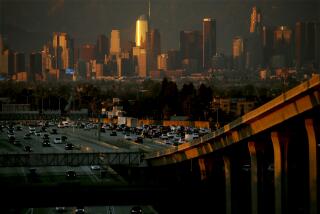One-third in state still live where air does not meet U.S. standards

The California Air Resources Board says smog remains above federal health standards in parts of greater Los Angeles, the San Joaquin Valley, Sacramento and San Diego.
Air pollution in California has dropped significantly over the last decade, yet about one-third of the population lives in communities where the air does not meet federal health standards, state officials reported Thursday.
The evaluation of smog and soot levels was presented at a meeting in Sacramento of the California Air Resources Board, which oversees the state’s progress in cleaning air that remains among the dirtiest in the nation.
Despite falling 15% to 20% in urban areas since 2003, smog remains above federal health standards in parts of Greater Los Angeles, the San Joaquin Valley, Sacramento and San Diego, the board’s report said.
Of the state’s five biggest urban areas, only the San Francisco Bay Area meets all federal standards for ozone — the worst component of smog — and fine particulate matter, or soot, according to the board, which took no action after hearing the staff report.
The assessment came as exceptionally dry and stagnant weather this winter has worsened air pollution across California and the Southwest, with some of highest levels in the Central Valley. Air board officials said continuing spells of bad air could set the state back.
“I don’t think we should be too congratulatory because this year has been a bad year,” said board member John Balmes, a professor of medicine at UC San Francisco.
In the South Coast region, which includes Los Angeles and Orange counties, the number of high-ozone days has dropped 21% since 2003 and state officials now estimate about 60% of people — including all coastal residents — live where smog meets federal health standards. But 6 million people in inland areas still live with unacceptably smoggy air.
In the San Joaquin Valley, only one-quarter of the population enjoys air quality that meets federal health standards for ozone. Though the number of high-ozone days in the valley has fallen 35% since 2003, some 3 million people live in areas where smog levels are too high, according to the air board’s estimates.
Fine-particle pollution, a bigger problem in winter, also has declined in California since 2003, though less steadily, air board officials reported. Levels in the San Joaquin Valley, for instance, rose to a peak in 2009 before dropping again. In the South Coast district, annual readings have dropped nearly in half since 2002 but remain above federal standards.
The report did little to assuage residents of the San Joaquin Valley, which has been cloaked in a thick haze of fine-particle pollution for many weeks since December. Air quality activists there responded with calls for new emissions reduction measures to bring immediate relief.
“It’s visible and it’s affecting our daily lives,” said Dolores Weller, interim director of the Central Valley Air Quality Coalition. “Children are being kept indoors for days on end, and sporting activities are being canceled. If there’s been an improvement in the last 10 years, we’re not seeing it here.”
Health studies link ozone and fine-particle pollution to respiratory illness and other health problems, including asthma, heart disease and cancer.
Curbing smog over the next decade will require big cuts in nitrogen oxides and volatile organic compounds, according to the board’s report. Those gases — emitted by vehicles, factories and power plants — react in the air to form ozone and fine particles.







